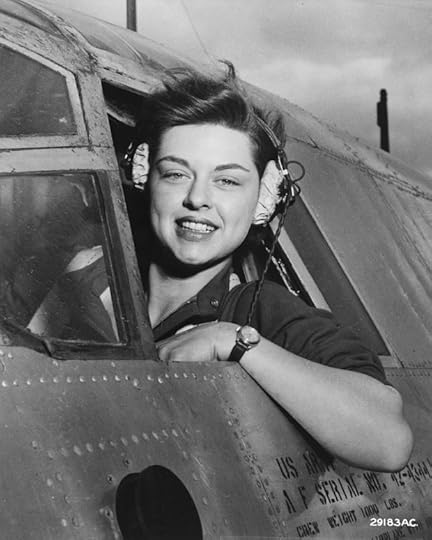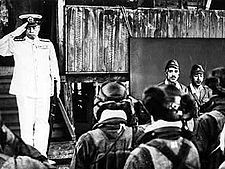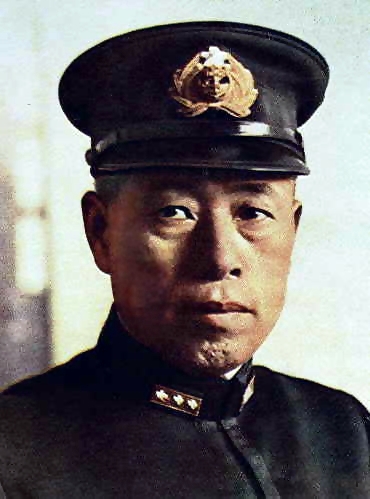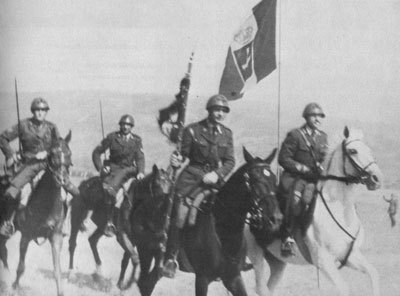Mark Scott Smith's Blog: Enemy in the Mirror, page 104
March 3, 2016
FEMALE WASPS WWII

Wikimedia Commons
The Women Airforce Service Pilots (WASP) was a paramilitary aviation organization formed in 1943 from the Women’s Flying Training Detachment (WFTD) and the Women’s Auxiliary Ferrying Squadron (WAFS). During WWII, over 1000 female WASP pilots flew military aircraft under the direction of the United States Army Air Force (USAAF).
Of ~ 25,000 female applicants with civilian pilot’s licenses, 1000 became the first women to fly American military aircraft.
Although their basic flight instruction was similar to male aviation cadets, WASPs were not trained for combat. While learning maneuvers needed to recover from any position, WASPs received no gunnery training, and little formation or aerobatic flying techniques.
WASPs, stationed at 120 U.S. air bases across the U.S., assumed numerous missions, that relieved male pilots for combat duty. WASPs flew from aircraft factories to ports of embarkation and military training bases, towed targets for anti-aircraft practice, simulated strafing missions, and transported cargo.
WASPs flew most types of USAAF aircraft during WWII. A few exceptional women pilots tested rocket or jet-propelled planes and worked with radar-controlled targets.
38 WASPs died in WWII accidents – eleven during training and 27 on active duty. But, because they were not considered active military personnel, a dead WASP received no posthumous awards for bravery nor traditional military honors. It was even forbidden to place an American flag on the coffin of the fallen WASP!
In December 1944, with Allied victory in sight, the WASP was disbanded and female pilots were sent home without official recognition of their service. Not until 1977, were WASPs granted veteran status. In 2009, they received the Congressional Gold Medal.
In 2002, the Army granted WASPs military funeral honors (playing Taps, a rifle salute, an American flag for the family) and affirmed they were eligible to have urns buried at Arlington national Cemetery. However in March 2014, citing lack of space, permission for a military WASP funeral at Arlington was rescinded. Now, pending several bills in Congress to remedy the situation, these gallant women pilots have once again been abandoned.
Read more:
The post FEMALE WASPS WWII appeared first on Enemy in the Mirror.
February 29, 2016
WWII Toys

www.oldwoodtoys.com (photo by Richard Mueller, Jr.)
In January 1942, the United States War Production Board (WPB) began rationing food, gasoline and other resources deemed important to the war effort. In addition, many American factories converted to production of war materials.
In March 1942, the WPB issued an order prohibiting the production of toys that contained critical materials (iron, steel, zinc, and rayon) that made up more than 7% of their weight.
In compliance with the WPB order, toy manufacturers began producing items such as paper dolls, puzzles, board games and hobby sets with military themes. For example, the Lionel Corporation (famous for toy electric trains) produced a freight train made entirely out of heavy-duty paper stock.
Read more:
Toy Production during World War II
Wood & metal children’s toys made before 1945
The toy Fuhrer model that was made for German children
The post WWII Toys appeared first on Enemy in the Mirror.
February 25, 2016
山本五十六 Yamamoto Killed – 1943

Admiral Isoroku Yamamoto, a few hours before his death, saluting Japanese naval pilots at Rabaul, April 18, 1943 – Wikimedia Commons

Isoroku Yamamoto, the architect of Imperial Japan’s attack on Pearl Harbor, lived in the United States from 1926-28 as a young naval attaché in Washington D.C. Impressed by American vitality and industrial capacity, he cautioned Japan’s military planners that a war with the USA would prove costly.
In his private life, Yamamoto was a calligrapher and poet who also enjoyed challenging games such as billiards, bridge, Ma Jong, poker, Shoqui (a chess-like game) and gambling. The father of four children, but apparently not close with his wife, Yamamoto was a frequent visitor at geisha houses.
As commander of Japan’s naval forces in the Pacific, Admiral Yamamoto was an advocate of air power. Early in the Pacific War, he promoted a strategy intended to draw the U.S. into a decisive naval battle that would force a negotiated peace. The catastrophic outcome of the Battle of Midway Island in June 1942 is seen by most historians as the major turning point in the Pacific War.
In the early morning of April 18, 1942, unaware of Allied decryption of Japan’s secret military messaging cipher , Admiral Yamamoto took off from the Japanese stronghold at Rabaul with a bomber and fighter escort. At his intended destination Bougainville Island, he planned an inspection tour, hoping to boost the morale of Japanese troops who, after the fall of Guadalcanal, were struggling to maintain control of the Solomon Islands.
That same morning, acting on intercepted radio transmissions regarding Yamamoto’s flight plan, 18 fork-tailed P-38G Lightnings left Henderson Field on Guadalcanal. To avoid detection, the Americans flew in radio silence, 50 feet above the water.
At 0930 AM, after two hours in the air, the American “Killer Flight” group engaged the bombers and Zero fighters transporting Yamamoto. Raked with machine gun fire, Yamamoto’s bomber crashed in the jungle. A search party later found Yamamoto’s body, thrown from the plane, still sitting in his seat with a hand on his Samurai-style katana sword. There were two bullet holes in his head and shoulder.
The post 山本五十六 Yamamoto Killed – 1943 appeared first on Enemy in the Mirror.
February 22, 2016
Dietrich Bonhöffer – Martyr

Dietrich Bonhöffer (1906 –1945) was a German Lutheran theologian and founding member of the Confessing Church that arose in opposition to government-sponsored efforts to permeate German Protestant churches with Nazi doctrine.
An outstanding academic theologian, Bonhöffer obtained his bachelor’s and master’s degrees at the University of Tübingen, a Doctor of Theology and an additional Doctorate of Habilitation (the highest degree available) at the University of Berlin. In 1930 Bonhöffer completed postgraduate study and a teaching fellowship at Union Theological Seminary in New York.
Bonhoeffer voiced staunch resistance to the Nazi euthanasia program and genocidal persecution of Jews. Arrested in April 1943 by the Gestapo, he was imprisoned for one and a half years before being transferred to a concentration camp. Accused of being an accomplice in the plot to assassinate Hitler, he was executed in April 1945.
Since his death, Dietrich Bonhöffer’s thoughts on the role of Christianity in the secular world have been widely disseminated. His book The Cost of Discipleship is considered by many to be a modern classic.

“In “Strange Glory,” Charles Marsh, a professor of religious studies at the University of Virginia, renders Bonhoeffer’s life and thought in exquisite detail and with sympathetic understanding, and in the course of more than 500 pages, we see Bonhoeffer’s transformation from pampered scion and theological dilettante to energetic churchman and Christian martyr, all against the backdrop of cataclysmic changes in Germany...” – NY Times August 8, 2014
The post Dietrich Bonhöffer – Martyr appeared first on Enemy in the Mirror.
February 18, 2016
Pentagon Constructed – 1943

Before the Pentagon was built, the United States Department of War, a civilian agency created to administer the U.S. Army, was spread out in temporary buildings in Washington, D.C., Maryland and Virginia.
With the onset of the European conflict in 1939, the War Department rapidly expanded in anticipation of U.S. entry into WWII. Designed by the architect George Bergstrom, construction of the Pentagon building began in September 1941. The building was dedicated in January 1943.
Across the Potomac River from Washington, D.C., the Pentagon has five sides, two basements, five floors above ground with five ring corridors per floor and a five-acre central plaza shaped like a pentagon.
Source: The Pentagon – Wikipedia, the free encyclopedia
The post Pentagon Constructed – 1943 appeared first on Enemy in the Mirror.
February 15, 2016
Japan Withdraws From Guadalcanal (ケ号作戦)
This mesmerizing video captures the fierce action of the battle for Guadalcanal, the first major offensive by Allied forces against the Empire of Japan.
By the end of 1942, all attempts by the Japanese army to recapture Henderson Air Field on Guadalcanal had been repulsed with heavy losses. Japanese troops were beginning to die from starvation and lack of adequate medical care. Japanese naval forces in the area were also suffering heavy losses in attempts to reinforce and resupply their ground forces.
In January 1943 the Japanese decided to concede the island of Guadalcanal to Allied Forces. Operation Ke (ケ号作戦) evacuated 10,652 Japanese soldiers at a cost of one destroyer sunk and three damaged. On February 9, Allied forces declared Guadalcanal secure, ending the six-month bloody campaign for control of the island.
USA JAPAN
Dead: 7,100 19,200 (8,500 killed in action)
Wounded: 7,789+ ?
captured: 4 11
ships lost: 29 38
aircraft lost: 615 683-880
The post Japan Withdraws From Guadalcanal (ケ号作戦) appeared first on Enemy in the Mirror.
February 11, 2016
Die große Liebe – 1942
Die große Liebe (The Great Love), which premiered in 1942, became the most commercially successful film in the history of the Nazi Germany. From the film’s musical score: “Davon geht die Welt nicht unter” and “Ich weiß, es wird einmal ein Wunder gescheh’n” became big hits.
The plot: Paul, a Luftwaffe fighter pilot stationed in North Africa, flies to Berlin to deliver a report and is given a day’s leave. At a cabaret, he sees the popular Danish singer Hanna and falls in love. After the performance, he accompanies her home and they are forced to take cover in an air raid shelter. After spending the night spent together, Hanna says she loves him, but he must return to the front. Although a series of miscommunications and missed opportunities keeps them apart, their bond grows. Paul asks Hanna to marry him but is called to duty on the night before the wedding. Hanna then leaves for Rome for a guest appearance. Paul manages to get leave, but the wedding is again postponed because Paul feels he is needed at the front. There is an argument and Paul thinks he’s has lost Hanna forever. When the war in Russia breaks out in 1941, Paul is sent to the Eastern Front. After he is wounded, Hanna comes to the hospital and agrees to marry him. In the finale, confident in the future, Paul and Hanna look skywards as squadrons of German bombers fly by.
The post Die große Liebe – 1942 appeared first on Enemy in the Mirror.
February 8, 2016
The Last Cavalry Charge – 1942

After infantry and chariots, cavalry formed some of the oldest military units in history. With lightning speed, mounted warriors often proved key to victory in many major battles. Although this advantage was mostly lost with the introduction of firearms and mechanized vehicles, WWII saw the last deployment of cavalry.
In 1939 Poland launched a number of unsuccessful cavalry attacks against invading German panzer units.
In August 1942, the Italian Savoy Cavalry , flanking the German offensive near Stalingrad, encountered a Red Army rear guard of 2000 men. Four squadrons of 150 Italian troopers moved toward the 812 Siberian Infantry Regiment in a walk, then charged directly into the superior Russian force with a ferocious saber attack. With the Siberian defense in complete disarray, the Savoy Cavalry dismounted and engaged the enemy in hand-to-hand combat. With a loss of 40 men, the Italians killed 150 Russians and captured 500.
The post The Last Cavalry Charge – 1942 appeared first on Enemy in the Mirror.
February 4, 2016
American Music WWII
Unlike songs popular in America during WWI , many WWII songs focused more on romance and strength instead of patriotism. Particularly popular, were singers included Frank Sinatra, Ella Fitzgerald, the Andrews Sisters and Bing Crosby.
Listen on YouTube to these popular songs often played on the radio:
Boogie Woogie Bugle Boy, Shoo Shoo Baby, I’m Making Believe, I’ll Be Seeing You, and I’ll Be Home for Christmas.
Listen on YouTube to popular songs that made fun of the Axis Powers:
We’ll Knock the Japs Right into the Laps of the Nazis, Yankee Doodle Ain’t Doodlin’ Now, You’re a sap Mr. Jap, Der Fuehrer’s Face
Listen to a WWII jukebox:
The post American Music WWII appeared first on Enemy in the Mirror.
February 1, 2016
Umi Yukaba – 海行かば
This rather eerie military song (軍歌 gunka) Umi Yukaba 海行かば was based on an ancient 和歌 waka poem by Ōtomo no Yakamochi and put to music by Nobutoki Kiyoshi in 1937. Popular throughout WWII, Umi Yukaba was sung by departing Kamikaze pilots (神風) during the last stages of the Pacific War.
If I go away to the sea, I shall be a corpse washed up.
If I go away to the mountain, I shall be a corpse in the grass.
But if I die for the Emperor, It will not be a regret.
The post Umi Yukaba – 海行かば appeared first on Enemy in the Mirror.
Enemy in the Mirror
I began by posting events around the turn This website www.enemyinmirror.com explores the consciousness, diplomacy, emotion, prejudice and psychology of 20th Century America and her enemies in wartime.
I began by posting events around the turn of the 20th century as I was researching my first novel about the Pacific War. I continued through WWII for my second novel about the Battle of the Atlantic. Now I am beginning to look at the Cold War as I gather information for my next novel about the Korean War. ...more
- Mark Scott Smith's profile
- 7 followers



